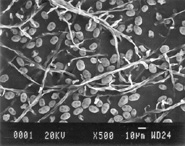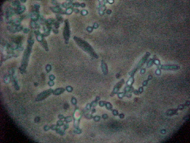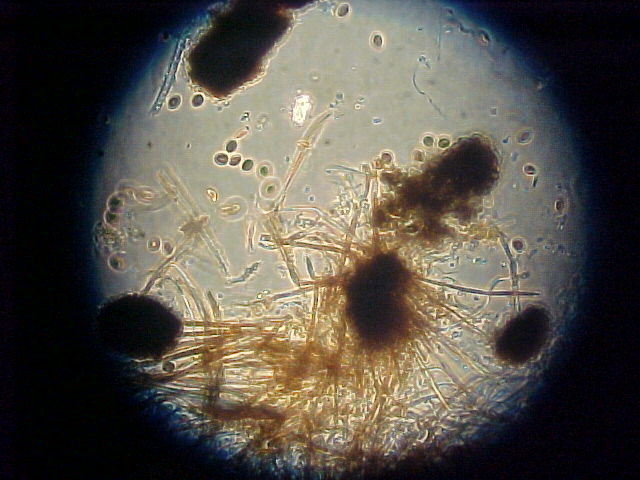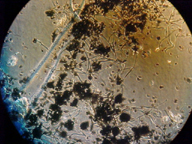We have completed mold inspection of 1000's sites, we get calls from all over the country from clients who have questions about mold. 90% of the people who say they know mold don't. Less than a dozen states have mold regulations so their is no is a list of common types of mold.
What is bad mold?
Like peanuts or gluten, bad is something that affects you adversely. The bad mold is the one you are allergic to.
What is black mold?
There is no mold called black mold. The media and companies selling mold services will tell you have black toxic mold, don't worry, neither one is real.
What is black toxic mold?
It is a name made up to scare you and to buy over proceed mold services.
Types of Mold
If you live in the Northeastern United States these are common mold and their sources.
Alternaria is a genus of ascomycete fungi. they known as major plant pathogens. Causes common allergens in humans, growing indoors and causing hay fever or hypersensitivity reactions that sometimes lead to asthma. They readily cause infections with those who have a compromised immune system.
Acremonium is a genus of fungus that consists of approximately 100 species. Found in wet cellulose (building materials) and grows well in areas of moisture and high levels of humidity. Can be toxic if ingested.
Aspergillus/Penicillium: Commonly found on water-damaged (impacted) materials also ubiquitous in the environments, levels above 500 are considered an issue.

Basidiospores: Ubiquitous, found in gardens, forests and woodlands. In the vast majority of cases, basidiospores that are detected in air samples are not from indoor growth. They are typically brought in through windows and doors. Basidiospores distributed by wind and released during periods of high humidity or rain. Dry rot, wood rot and brown rot are all the result of basidiospores producing fungi.
Cladosporium is common in the air and on surfaces such as wallpaper or carpet, particularly where moisture is present. Cladosporium species rarely causes human illnesses, but can cause allergic symptoms. The airborne spores of Cladosporium species are significant allergens, and in large amounts, they can severely affect asthmatics and people with respiratory diseases. Cladosporium species produce no major mycotoxins of concern, but do produce volatile organic compounds (VOCs) associated with odors. The numbers are often high in the summer; the outdoor numbers are largely reduced in the winter. Acute symptoms included edema and bronchiospasms, chronic cases may develop pulmonary emphysema. In an indoor environment, Cladosporium occur as secondary wall colonizers, typically appearing after the primary ones such as Penicillium species, Aspergillus versicolor and Wallemia sebi. When found indoors very common on wet building material (e.g., gypsum board, acrylic painted walls, wood, wallpaper, carpet and mattress dust, HVAC fans, and wet insulation in mechanical cooling units).

Chaetomium: These spores are ubiquitous and are formed in fruiting bodies where spores are forced out and spread by air and water movement. Commonly found on damp sheetrock. They can be found as causative agents in humans, therefore they are fungi that can cause infections. Chaetomium exposure is known to be an allergen and causes respiratory issues. It has also been linked to cases of severe infections, and mycotoxic varieties may be a threat to the health of individuals with compromised immune systems.

Curvularia is a hyphomycete fungus, which is a facultative pathogen of many plant species and of the soil. Grows on a variety of materials. Type I allergies (hay fever, asthma). A relatively common cause of allergic fungal sinusitis
Epithelia are formed of cells that line the cavities in the body and cover flat surfaces. Of the four major tissue types found in the human body epithelial cells are by far the most prolific.
Epiococcum: Ubiquitous and can be found in plant debris. Distinctive and readily identifiable on tape lift samples
Epithelial Cells: Layers of cells that line hollow organs and glands. Those make up the outer surface of the body.
Hyphal Elements: single, unidentifiable fragments of mold; may cause allergic reactions in some people. Presence can indicate growth.
Myxomycetes normally grow in cool, shady, moist places on decaying wood, leaves or other organic matter retaining lots of moisture. Bark mulch in a flower garden, shrub bed or over watered lawn are a few examples. Pollens, Pollen is very fine powder that comes from trees, grasses, flowers and weeds. Ascospores, generally considered "outdoor" spores, there are Ascomycetes that grow well indoors on wet materials. Ascospores are sexual spores of the group of fungi known as Ascomycetes.
Periconia/Smut/Myxo: Periconia, Widespread outdoor fungus commonly found on various substrates including stalks of grasses, herbaceous stems, dead leaves or leaf spots. These are also common symbiotic root colonizing fungi in the tall grass prairie. Smut means a particle of dirt or a smudge made by soot smoke or dirt.
Pithomyces spores commonly found on dead leaves. Most often found outside, can grow inside (rarely) on paper when conditions are right
Pithomyces is a soil borne ubiquitous fungus. The genus Pithomyces contains more than 40 species, occurring on dead leaves of more than 50 different plants, especially in leaf fodders, soil and grasses. It is rarely found growing indoors, but can grow on paper under the right conditions. It has also been reported from ceiling tiles, carpet and mattress dust.
Stachybotrys grows when water is available for prolonged periods of time and will grow well on cellulose materials.

Ulocladium is a genus that contains both plant pathogens and food spoilage agents. Some members of the genus can invade inside of homes where moisture and water are found.
Call the professionals
Monday to Friday 8:00 am to 5:00 pm EST.
888-301-1050
If you are contacting us during non business hours complete the form on the right side of the page and an environmental manager will contact you on the next business day.
